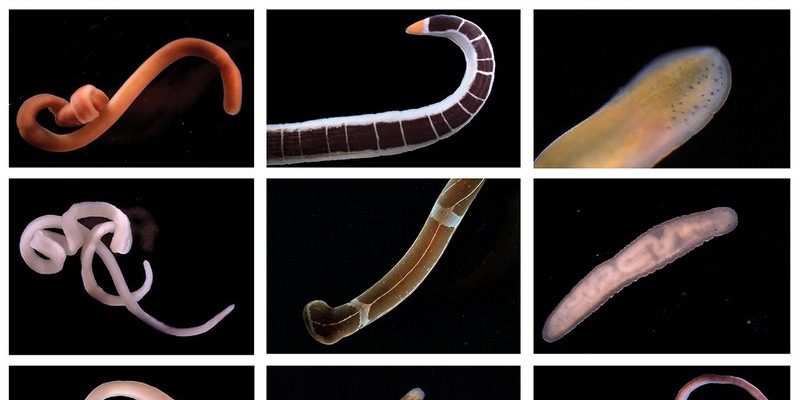
Let’s dive deeper into the intriguing evolutionary history of ribbon worms. Have you ever wondered how these soft-bodied, elongated creatures came to be? Understanding their past not only sheds light on their unique adaptations but also helps us appreciate the intricate web of life in our oceans. From ancient origins to surprising traits, the evolution of ribbon worms paints a picture of resilience and ingenuity in the face of environmental challenges.
What Are Ribbon Worms?
Before we jump into their evolutionary history, let’s clarify what ribbon worms actually are. These fascinating creatures belong to the phylum **Nemertea**, and they’re known for their long, slender bodies that can reach impressive lengths—some species are over 30 meters long! They primarily inhabit marine environments but can also be found in freshwater and terrestrial ecosystems.
Ribbon worms are captivating not just in size but in their unique biology. They possess a specialized structure called a **proboscis**. This is a long, retractable tube that they can extend to catch prey, much like a chameleon flicking out its tongue. This adaptation is crucial for their survival, allowing them to snatch up small fish and invertebrates.
You might be wondering how they fit into the grander scheme of evolution. Well, that’s where things get interesting, and we’ll explore this journey through time.
The Origins of Ribbon Worms
The story of ribbon worms starts over 500 million years ago, back in the Cambrian period. This was a time when life in the oceans was rapidly evolving, and many of today’s major animal groups began to appear. Fossil evidence suggests that ribbon worms share a common ancestor with other invertebrates, like flatworms and annelids (segmented worms).
What’s fascinating is that the **nemerteans** are believed to be one of the earliest animal phyla to develop a complete digestive system. This means that, unlike some simpler organisms that rely on diffusion for nutrient uptake, ribbon worms evolved to have specialized parts for digestion. This big step was crucial and allowed ribbon worms to exploit a wider range of food sources.
As we trace their lineage, we see how ribbon worms adapted to various environments, transitioning from shallow waters to deeper, more complex ecosystems. This adaptability shows the resilience and versatility of these creatures as they navigated changing oceanic conditions.
Key Features That Set Ribbon Worms Apart
You’re probably curious about what makes ribbon worms so unique. For starters, their **proboscis**, as mentioned earlier, is quite a remarkable feature. This organ is not just for show—it’s a vital tool for hunting. When prey is detected, the worm quickly extends its proboscis, often covered in sticky or venomous mucus, to capture its victim. Imagine fishing with a super-advanced net that can shoot out and reel in dinner!
Another standout trait is their **regenerative abilities**. Ribbon worms can regenerate lost parts, including segments of their body and even internal organs. This ability likely evolved as a survival mechanism, allowing them to recover from predators’ attacks. If a predator nips off part of a worm, it can grow it back, much like a lizard regrowing its tail.
In addition to these features, ribbon worms exhibit a fascinating variety of colors and patterns. This diversity isn’t just aesthetic; it may serve important roles in camouflage and communication. Bright colors can signal danger to other animals, while more muted tones blend in with the ocean floor.
The Role of Ribbon Worms in Ecosystems
Ribbon worms play a crucial role in their ecosystems. They are not just passive residents of the ocean; they are active participants in the food web. By preying on smaller organisms, they help control populations and maintain balance in their habitats. In turn, they serve as food for larger predators, creating a dynamic cycle of life.
Their burrowing habits also contribute to ecosystem health. As they dig into the sediment, they aerate the soil, allowing for better water and nutrient flow. This activity can have a positive impact on the overall health of marine environments, supporting the growth of other organisms, including plants and fish.
Additionally, ribbon worms are important for scientific research. Understanding their biology and evolution can provide insights into broader evolutionary processes. Researchers study these organisms to learn more about developmental biology and the evolution of complex life forms.
Fossil Records and What They Tell Us
Fossil records play a significant role in piecing together the evolutionary history of ribbon worms. While soft-bodied creatures like nemerteans rarely fossilize, some fossils suggest that ribbon worms have existed in various forms for hundreds of millions of years.
For example, fossils found in sedimentary rocks indicate that ancient ribbon worms were present during significant geological events, like the formation of mountain ranges and shifting ocean currents. Studying these fossils helps scientists reconstruct ancient marine environments, providing clues about how ribbon worms adapted to past changes.
The oldest known ribbon worm fossil dates back to around 400 million years ago, showing that they’ve been around long enough to witness and adapt to monumental changes on Earth. This resilience is a testament to their evolutionary success, offering a fascinating glimpse into the adaptability of life through time.
Modern Ribbon Worms: Diversity and Distribution
Today, there are over 1,300 known species of ribbon worms, showcasing incredible diversity in form, size, and habitat. They range from the familiar to the bizarre, with vibrant colors and unique adaptations. Some species inhabit coastal regions, while others prefer the deep sea.
In terms of distribution, ribbon worms are found all over the world, from the Arctic to tropical waters. They thrive in various environments, including sandy beaches, rocky shorelines, and even freshwater streams. This adaptability contributes to their widespread presence and underscores their importance in numerous ecosystems.
Despite their abundance, ribbon worms are often overlooked in discussions about marine life. That’s a shame, considering they play vital roles in food webs and have fascinating traits worthy of attention.
Why Understanding Ribbon Worm Evolution Matters
So, why should we care about the evolution of ribbon worms? Beyond their quirky appearances and unique biology, studying these creatures helps us understand fundamental biological processes and the complexities of life on our planet.
By looking at how ribbon worms evolved, we can learn about the mechanisms of adaptation and survival in changing environments. Their history offers valuable lessons on biodiversity and the importance of preserving ecosystems, especially as modern threats like climate change and habitat destruction loom large.
Learning about these ancient creatures also connects us to the broader tapestry of life. Every organism has a role, and ribbon worms remind us that even the smallest and most unassuming creatures have fascinating stories woven into the fabric of our planet’s history.
In conclusion, the evolutionary history of ribbon worms is a captivating tale of resilience, adaptability, and ecological importance. These creatures not only bring color and life to our oceans but also serve as a reminder of the many mysteries still waiting to be uncovered in the natural world. Understanding their past allows us to appreciate the intricate connections we all share in the web of life. So, the next time you’re by the ocean, take a moment to think about the quiet ribbon worms and their journey through time!

